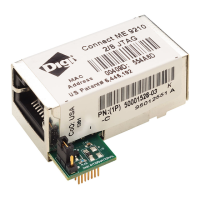Digi Connect and ConnectPort TS Family web interface Configuration through the web interface
Digi Connect Family and ConnectPort TS Family
74
n Enable Simple Network Management Protocol (SNMP) traps: Enables or disables the
generation of SNMP traps.
l Trap Destinations: Provide the IP address or fully qualified domain name (FQDN) of the
system where the SNMP agent sends traps. The primary destination is required. The
secondary destination is optional.
l Primary/Secondary: The IP address of the system to which the SNMP agent sends traps.
To enable any of the traps, you must specify a non-zero value. The primary destination is
required. The secondary destination is optional. If your Digi devices supports alarms, you
must complete this field in order to send alarms in the form of SNMP traps. See Alarms
Configuration.
You can use the following SNMP trap check boxes:
l Generate authentication failure traps: The SNMP agent will send SNMP authentication
traps when there are authentication failures.
l Generate login traps: The SNMP agent sends SNMP login traps on login attempts.
l Generate cold start traps: The SNMP agent sends traps on cold starts of the Digi device.
l Generate link up traps: The SNMP agent sends link up traps when network connections
are established.
Date and Time Settings
Use the Date and Time Settings page to set the Coordinated Universal Time (UTC) and/or system
time and date on a device, or set the offset from UTC for the Digi device's system time.
Set the date and time
To set the date and time, click the Set button to configure the hours, minutes, seconds, month, day,
and year on the device.
If offset is set to 00:00, the device's system time and UTC are the same. Setting time and date with an
offset of 00:00 results in both UTC and system time being set to the specified value. If offset is not
00:00, setting time sets the system time to the specified value and UTC is adjusted accordingly.
Offset from UTC
Specifies the offset from UTC for this device. Offset can range from -12 hours to 14 hours. Very rarely,
a time zone can also have an offset in minutes (15, 30, or 45). You can use this value to modify the time
and date (generally expected to be UTC) to compensate for time zones and daylight savings time.
Wikipedia provides a list of time zone offsets at: https://en.wikipedia.org/wiki/Lists_of_time_zones
On a device with no real-time clock (RTC) and no configured time source, time and date are
completely local to the device and have limited usefulness since they are not persistent over
reboots/power-cycles.
On a device with a real-time clock and no configured clock source, time and date are also local to the
device but they are meaningful because they are persistent. The offset option could be useful in
adjusting for daylight savings time. Setting the date and time to standard time and setting offset to 1
whenever daylight savings time is in effect would serve that purpose.
On a device with a configured clock source, time and date received from a clock source is expected to
be UTC. For users with several devices in different time zones, keeping offset=00:00 might be useful
for comparing logs or traces from different devices, since all would be using UTC.

